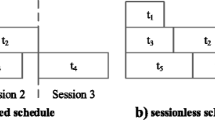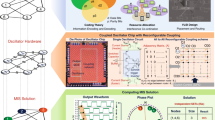Abstract
The total logic activity produced in a digital circuit during testing, and hence the total energy consumed, is an invariant of a set of tests. Faster we consume this energy, shorter will the test time be. Thus, to minimize the test time we may maximize the power during test by using a dynamically selectable clock frequency. This idea is exploited in our solution for the problem of finding clock frequencies under the constraints of maximum allowable power and critical path delay. A very efficient but approximate kth-root solution finds k test clock frequencies, which are further optimized by a locally exhaustive search (LES) algorithm. Both solutions have an O(N×k) complexity for finding k clock frequencies when the test runs through N clock cycles, though kth-root solution is about two orders of magnitude faster to compute than LES. In practice, LES gives optimally minimum test time and is matched by the kth-root solution for k ≥ 10.






Similar content being viewed by others
References
ATPG and Failure Diagnosis Tools. Mentor Graphics Corp., Wilsonville, OR, 2009
Bhunia S, Mahmoodi H, Ghosh D, Roy K (2005) Power reduction in test-per-scan BIST with supply gating and efficient scan partitioning. In: Proceeding 6th IEEE International Symp. Quality Electronic Design, pp 453–458
Brownlee J (2012) Clever Algorithms: Nature-Inspired Programming Recipes. Available from Amazon.com
Bushnell ML, Agrawal VD (2000) Essentials of electronic testing for digital, memory and mixed-signal VLSI circuits. Springer, Boston
Castro J, Parra P, Valencia M, Acosta AJ (2007) A switching noise vision of the optimization techniques for low-power synthesis. In: Proceeding 18th European Conf. Circuit Theory and Design, pp 156–159
Cormen TH, Leiserson CE, Rivest RL, Stein C (2009) Introduction to algorithms, 3rd edn. MIT Press
Girard P, Wen X, Touba NA (2008) Low power testing. In: Wang L-T, Stroud C E, Touba N A (eds) System on chip test architectures. Morgan-Kaufmann, Amsterdam, pp 306–350
Gunasekar S (2014) Finding Optimum Clock Frequencies for Aperiodic Test, Master’s thesis, Auburn University, ECE Department, Auburn, AL, USA
Gunasekar S, Agrawal VD (2014) Selecting ATE frequencies for power constrained test time reduction using aperiodic clock. In: Proceeding 23rd IEEE North Atlantic Test Workshop, pp 52–56
Gunasekar S, Agrawal VD (2015) Few good frequencies for power-constrained test. In: Proceeding 28th International Conf. VLSI Design, pp 393–398
Leonardo Spectrum User Guide. Mentor Graphics Corp, Wilsonville, OR, 2011
MATLAB Version 7.14.0.739 (R2012a) Natick, Massachusetts: The MathWorks Inc., 2012
Nanosim User Guide. Synopsys, San Jose, CA, 2008
Necchi L, Lavagno L, Pandini D, Vanzago L (2006) An ultra-low energy asynchronous processor for wireless sensor networks
Ravi S (2007) Power-aware test: challenges and solutions. In: Proceeding International Test Conf., pp 1–10. Lecture 2.2
RTL Models for ISCAS’89 Benchmarks. Available from www.pld.ttu.ee/~maksim/benchmarks/, accessed Aug. 10, 2014
The Spice Page. http://bit.ly/1b72tyv (accessed Nov. 28, 2013)
Venkataramani P (2014) Reducing ATE test time by Voltage and Frequency Scaling. PhD thesis, Auburn University, ECE Department, Auburn, AL, USA
Venkataramani P, Agrawal VD (2012) Reducing ATE time for power constrained scan test by asynchronous clocking. In: Proceeding IEEE International Test Conf. Poster P13
Venkataramani P, Agrawal VD (2013) ATE test time reduction using asynchronous clock period. In: Proceeding International Test Conference. Paper 15.3
Venkataramani P, Sindia S, Agrawal VD (2014) A test time theorem and its applications. J Electronic Testing: Theory and Applications 30(2):229–236
Yang B, Sanghani A, Sarangi S, Liu C (2011) A clock-gating based capture power droop reduction methodology for at-speed scan testing. In: Proceeding Design, Automation Test in Europe Conf. and Exhibition, pp 1–7
Zhu QK (2004) Power Distribution Network Design for VLSI. Wiley-Interscience
Acknowledgments
This research was supported in part by NSF Grants CNS-0708962, CCF-1116213 and IIP-0738088.
Author information
Authors and Affiliations
Corresponding author
Additional information
Responsible Editor: K. K. Saluja
This research was originally presented at 28th International Conference on VLSI Design, Bangalore, India, January 3-7, 2015.
Rights and permissions
About this article
Cite this article
Gunasekar, S., Agrawal, V.D. A Maximum Power Algorithm to Find Frequencies for Aperiodic Clock Testing. J Electron Test 31, 403–410 (2015). https://doi.org/10.1007/s10836-015-5536-2
Received:
Accepted:
Published:
Issue Date:
DOI: https://doi.org/10.1007/s10836-015-5536-2




